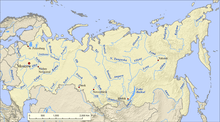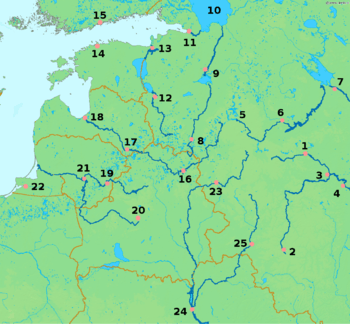List of rivers of Russia
Russia can be divided into a European and an Asian part. The dividing line is generally considered to be the Ural Mountains. The European part is drained into the Arctic Ocean, Baltic Sea, Black Sea, and Caspian Sea. The Asian part is drained into the Arctic Ocean and the Pacific Ocean.
Notable rivers of Russia in Europe are Pechora, Volga, Don, Kama, Oka and the Northern Dvina, while several other rivers originate in Russia but flow into other countries, such as the Dniepr and the Western Dvina.
In Asia, important rivers are the Ob, the Irtysh, the Yenisei, the Angara, the Lena, the Amur, the Yana, the Indigirka, and the Kolyma.
In the list below, the rivers are grouped by the seas or oceans into which they flow. Rivers that flow into other rivers are ordered by the proximity of their point of confluence to the mouth of the main river, i.e., the lower in the list, the more upstream.
There is an alphabetical list of rivers at the end of this article.


Barents Sea and White Sea (Arctic Ocean)
The rivers in this section are sorted east to west.
- Pechora (north-east of Naryan-Mar)
- Usa (west of Usinsk)
- Kolva (near Usinsk)
- Usa (west of Usinsk)
- Northern Dvina (in Severodvinsk)
- Pinega (in Ust-Pinega)
- Yomtsa (near Bolshaya Gora)
- Vaga (near Bereznik)
- Uftyuga (near Krasnoborsk)
- Vychegda (in Kotlas)
- Vishera
- Yug (in Veliki Ustyug)
- Sukhona (in Veliki Ustyug)
- Vologda (near Vologda)
- Mezen (near Mezen)
- Nautsiyoki
- Onega (in Onega)
- Kem (in Kem)
- Niva (in Kandalaksha)
- Malaya Belaya (on the Kola Peninsula in Murmansk Oblast)
- Varzuga (in Kuzomen)
- Ponoy (in Ponoy)
- Iokanga (in Iokanga)
- Voronya
Baltic Sea

The rivers in this section are sorted south-west to north-east.
- Pregolya (near Kaliningrad)
- Alle/Lava (in Znamensk)
- Instruch/Inster (in Chernyakhovsk)
- Angrapa (in Chernyakhovsk)
- Pissa (near Chernyakhovsk)
- Krasnaya River (in Gusev)
- Nemunas/Neman (near Šilutė, Lithuania)
- Šešupė (near Neman)
- Daugava/Western Dvina (near Riga, Latvia)
- Narva (near Narva)
- Luga (in Ust-Luga)
- Oredezh (near Luga)
- Neva (in Saint Petersburg)
- Okhta (in Saint Petersburg)
- Okkervil (in Saint Petersburg)
- Izhora (in Ust-Izhora)
- Tosna (in Otradnoye)
- Mga (near Mga)
- Lake Ladoga (in Shlisselburg)
- Volkhov (near Volkhov)
- Tigoda (near Kirishi)
- Ravan
- Chagoda
- Vishera (near Velikiy Novgorod)
- Lake Ilmen (in Velikiy Novgorod)
- Msta (near Velikiy Novgorod)
- Peretna (in Toporok)
- Uver (near Berezovsky Ryadok)
- Berezayka (in Berezovsky Ryadok)
- Valdayka
- Lake Mstino (near Vyshny Volochyok)
- Tsna (near Vyshny Volochyok)
- Pola (near Staraya Russa)
- Lovat (near Staraya Russa)
- Polist (near Staraya Russa)
- Kunya (in Kholm)
- Shelon (near Shimsk)
- Msta (near Velikiy Novgorod)
- Tigoda (near Kirishi)
- Syas (in Syasstroy)
- Svir (near Lodeynoye Pole)
- Pasha (near Lodeynoye Pole)
- Oyat (near Lodeynoye Pole)
- Lake Onega
- Vuoksi (in Solovyovo and Priozersk)
- Volchya (near Losevo)
- Volkhov (near Volkhov)
- Okhta (in Saint Petersburg)
- Sestra (near Sestroretsk)
Black Sea
The rivers in this section are sorted west to east.
- Dnieper (near Kherson, Ukraine)
- Desna (near Kiev, Ukraine)
- Seim (in Sosnytsia, Ukraine)
- Sudost (north of Novhorod-Siversky, Ukraine)
- Vyazma
- Desna (near Kiev, Ukraine)
- Mius (into Sea of Azov near Taganrog)
- Don (into Sea of Azov near Azov)
- Manych (in Manychskaya, east of Rostov-on-Don)
- Sal (in Semikarakorsk)
- Donets (near Semikarakorsk)
- Khopyor (near Serafimovich)
- Bityug (near Pavlovsk)
- Osered' (near Pavlovsk)
- Voronezh (near Voronezh)
- Temernik (near Rostov-on-Don)
- Yeya (into Sea of Azov near Yeysk)
- Kuban (into Sea of Azov near Temryuk)
- Laba (in Ust-Labinsk)
- Mzymta (near Sochi)
Caspian Sea
The rivers in this section are sorted west to east.
- Sulak (north of Makhachkala)
- Andi Koysu (near Gimry)
- Avar Koysu (near Gimry)
- Terek (near Kizlyar)
- Malka (near Prokhladny)
- Kuma (north of Kizlyar)
- Podkumok (near Georgiyevsk)
- Volga (near Astrakhan)
- Yeruslan (near Kamyshin)
- Tereshka (near Saratov)
- Bolshoy Irgiz (near Volsk)
- Maly Irgiz
- Chapayevka (near Chapayevsk)
- Samara (in Samara)
- Sok (in Samara)
- Kondurcha (north of Samara)
- Bolshoy Cheremshan (near Dimitrovgrad)
- Bezdna
- Aktay
- Kama (south of Kazan)
- Vyatka (near Nizhnekamsk)
- Belaya (near Neftekamsk)
- Chusovaya (near Perm)
- Sylva (near Perm)
- Yegoshikha (in Perm)
- Mulyanka (in Perm)
- Vishera (near Solikamsk)
- Kolva (near Cherdyn)
- Kazanka (in Kazan)
- Sviyaga (west of Kazan)
- Ilet (near Volzhsk)
- Anish (near Kozlovka)
- Malaya Kokshaga (near Kokshaysk)
- Maly Kundysh
- Bolshaya Kokshaga (near Kokshaysk)
- Bolshoy Kundysh
- Tsivil (near Novocheboksarsk)
- Rutka
- Vetluga (near Kozmodemyansk)
- Sura (in Vasilsursk)
- Pyana
- Alatyr (in Alatyr)
- Kerzhenets (near Lyskovo)
- Kudma (between Kstovo and Lyskovo)
- Oka (in Nizhny Novgorod)
- Uzola (near Balakhna)
- Unzha (in Yuryevets)
- Neya (near Makaryev)
- Viga
- Nyomda (near Yuryevets)
- Shuya
- Kostroma (in Kostroma)
- Vyoksa (in Buy)
- Kotorosl (in Yaroslavl)
- Sogozha (near Poshekhonye)
- Sheksna (in Cherepovets)
- Lake Beloye (near Belozersk)
- Kovzha
- Kema
- Lake Beloye (near Belozersk)
- Suda (near Cherepovets)
- Kolp
- Mologa (near Vesyegonsk)
- Kashinka (near Kalyazin)
- Nerl (near Kalyazin)
- Kubr
- Medveditsa (near Kimry)
- Dubna (in Dubna)
- Sestra (near Dubna)
- Shosha (near Konakovo)
- Lama (near Kozlovo)
- Tvertsa (in Tver)
- Osuga (near Torzhok)
- Vazuza (in Zubtsov)
- Selizharovka (in Selizharovo)
- Ural (in Atyrau, Kazakhstan)
Arctic Ocean, east of the Urals
The rivers in this section are sorted west to east.
- Ob (to Gulf of Ob)
- Irtysh (near Khanty-Mansiysk)
- Vakh (near Nizhnevartovsk)
- Sabun
- Tym (in Ust-Tym)
- Vasyugan (in Kargasok)
- Parabel (near Kargasok)
- Ket (near Kolpashevo)
- Chulym (in Ust-Chulym)
- Tom (50 km downstream from Tomsk)
- Aley (near Barnaul)
- Katun River (in Biysk)
- Biya River (in Biysk)
- Chulyshman (into Lake Teletskoye)
- Nadym (into Gulf of Ob in Khorovaya)
- Pur (into Gulf of Taz in Ivay-Sale)
- Taz (into Gulf of Taz in Tazovsky)
- Yenisei
- Tanama
- Turukhan (near Turukhansk)
- Abakan
- Kureika River
- Yeloguy
- Big Kheta
- Turukhan
- Sym
- Lower Tunguska
- Vivi River
- Bakhta River
- Stony Tunguska
- Katanga
- Tetere
- Big Pit River
- Kan River
- Mana River
- Bazaikha River
- Kacha River
- Kem River
- Khemchik River
- Khantayka
- Angara River (in Strelka)
- Oka (near Bratsk)
- Bolshaya Belaya (near Usolye-Sibirskoye)
- Irkut (in Irkutsk)
- Selenga (into Lake Baikal near Kabansk)
- Uda (in Ulan Ude)
- Khilok River
- Chikoy River
- Menza River
- Orkhon River
- Dzhida River
- Eg River (Mongolia)
- Barguzin River (into Lake Baikal in Ust-Barguzin)
- Turka River (into Lake Baikal)
- Upper Angara River (into Lake Baikal near Severobaykalsk)
- Taseyeva River
- Chuna River
- Kosovka River
- Biryusa River
- Chuna River
- Abakan (in Abakan)
- Pyasina (east of Gulf of Taz)
- Khatanga (near Kozhevnikovo)
- Anabar (at Khorgo)
- Olenyok (in Ust-Olenyok)
- Lena (near Tiksi)
- Omoloy
- Yana (in Nizhneyansk)
- Indigirka (near Tabor, Sakha)
- Allaikha
- Byoryolyokh
- Shandrin
- Kuydusun
- Kyuente
- Elgi
- Nera
- Moma
- Chibagalakh
- Badyarikha
- Selennyakh
- Druzhina
- Uyandina
- Alazeya
- Rossokha
- Kolyma (near Ambarchik)
- Anyuy (near Nizhnekolymsk)
- Bolshoy Anyuy River
- Maly Anyuy River
- Omolon (±80 km upstream from Nizhnekolymsk)
- Popovka
- Yasachnaya
- Zyryanka
- Ozhogina
- Sededema
- Buyunda
- Balygychan
- Sugoy
- Korkodon
- Beryozovka
- Anyuy (near Nizhnekolymsk)
- Chaun River
- Palyavaam River
- Pegtymel River (flowing into Chukchi Sea)
- Chegitun River
Pacific Ocean/Sea of Okhotsk
The rivers in this section are sorted north to south.
- Anadyr (in the Bering Sea)
- Paren
- Ola
- Kamchatka (in Ust-Kamchatsk)
- Avacha (near Petropavlovsk-Kamchatsky)
- Bolshaya (west coast of Kamchatka Peninsula)
- Kikhchik (west coast of Kamchatka Peninsula)
- Uda (in Chumikan)
- Amur (in Nikolayevsk-on-Amur)
- Anyuy (in Naykhin)
- Ussuri (in Khabarovsk)
- Bureya (near Raychikhinsk)
- Zeya (in Blagoveshchensk)
- Tom (±80 km upstream from Blagoveshchensk)
- Selemdzha (±50 km upstream from Svobodny)
- Dep
- Shilka
- Argun
- Tumen (in Sŏsura-ri, North Korea)
Unsorted
- Chernaya River(into Kamenka River (Saint Petersburg))
- Kosovoy
- Tuloma River
- Rosta River
Alphabetical list
A–G
Abakan, Alazeya, Aldan, Aley, Ambarnaya, Amga, Amur, Anabar, Anadyr, Angara River, Angrapa, Anyuy (Kolyma), Anyuy (Amur), Argun, Avacha, Barguzin, Bashkaus, Belaya, Berezayka, Bityug, Biya, Bolshaya Belaya, Bolshaya Pyora (Amur Oblast), Bolshaya Pyora (Komi Republic), Buotama, Bureya, Chagoda, Chebdar, Cheptsa, Chernaya, Chulym (Ob), Chulyshman, Chusovaya, Daugava/Western Dvina, Dep, Desna, Dnieper/Dnipro, Don, (Seversky) Donets, Dubna, El'duga
I–L
Ik, Ilek, Indigirka, Ingoda, Instruch, Iokanga, Irkut, Irtysh, Iset, Ishim, Istra, Izhora, Kama, Kamchatka, Kashinka, Kasplya, Katanga, Katun, Kazanka, Kerzhenets, Ket, Khatanga, Kheta, Khopyor, Kirenga, Klyazma, Kolva (Usa), Kolva (Vishera), Kolyma, Kondurcha, Kosovka, Kosovoy, Kostroma, Kotorosl, Kotuy, Kozhim, Krasnaya River, Kuban, Kubr, Kuma, Kunya, Laba, Lama, Lava/Łyna, Lena, Lovat, Lower Tunguska, Luga, Lyutenge
M–S
Malka, Malaya Belaya, Manych, Markha, Markha (Vilyuy), Matta, Maya, Mezen, Mga, Miass, Mius, Moksha, Mologa, Moskva, Msta, Mulyanka, Muna, Nadym, Nara, Narva, Nautsiyoki River, Neglinnaya, Nemunas/Neman, Nercha, Nerl (Klyazma), Nerl (Volga), Neva, Niva, Northern Dvina, Nyuya, Ob, Oka (Volga), Oka (Angara River), Olenyok, Olyokma, Om, Omolon, Onega, Onon, Oredezh, Osuga, Oyat, Pakhra, Pasha, Parabel, Pechora, Pinega, Pissa, Plava, Podkamennaya Tunguska, Podkumok, Pola, Polist, Polota, Ponoy, Pra, Pregolya, Protva, Pur, Pyasina, Ravan, Ruza, Sakmara, Sal, Samara, Seim, Selemdzha, Selenga, Sestra River (Leningrad Oblast), Sestra River (Dubna), Šešupė, Setun, Sheksna, Shelon, Shilka, Shosha, Sudost, Sukhona, Suola, Sura, Svir, Sviyaga, Syas, Sylva
T–Z
Tavda, Tara, Taz bien?, Terek, Tetere, Teza, Tigoda, Tobol, Tom (Ob), Tom (Zeya), Tosna, Tsna River (Moksha basin), Tsna River (Tver Oblast), Tugur, Tumen, Tura, Turukhan, Tvertsa, Tym, Tyung, Uda (Buryatia), Uda (Khabarovsk Krai), Ufa, Uftyuga, Ugra, Unzha, Upa, Upper Angara River, Ural, Usa, Ussuri, Uver, Uzola, Vaga, Vakh, Valdayka, Varzuga, Vasyugan, Velikaya, Vetluga, Vilyuy, Vishera (Volkhov), Vishera (Vychegda), Vishera (Kama), Vitim, Volchya (Vuoksi), Volga, Volkhov, Vologda, Voronezh, Voronya, Vuoksi, Vyatka, Vyazma, Vychegda, Vytegra, Yana, Yauza, Yegoshikha, Yomtsa, Yenisei, Yug, Yuryuzan, Zeya, Zhupanova
